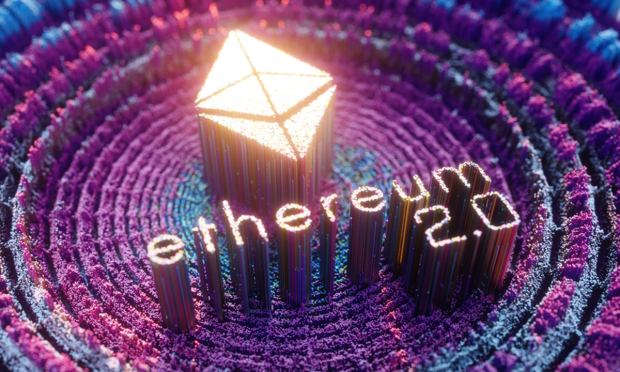Plans for Ethereum Spinoff Could Sputter without Backing of Top Stablecoins

A pollution-spewing version of the Ethereum blockchain will live on after the main smart contract platform switches to an environmentally friendlier, far more scalable technology next month. Just don’t try to buy anything on it.
Crucially, the two top stablecoin issuers, Tether and Circle, announced on Tuesday (Aug. 9) that their dollar-pegged tokens will only support the new proof-of-stake (PoS) Ethereum 2.0 blockchain that will emerge after the long-awaited “merge” happens on Sept. 19. At that time, almost all of the projects and platform currently using Ethereum will switch over to the new platform.
See also: Ethereum 2.0 Targeted for September with 100,000 TPS Close at Hand
While their backing of Ethereum 2.0 was never in any doubt, the usability and usefulness of a forked version of the old Ethereum 1.0 are questionable. Without the support of the two major stablecoin issuers, those questions grow harder to answer.
Read more: Blockchain Series: What is Avalanche?
Ethereum PoW — Hit or Miss?
That said, there appears to be enough support to keep a version of Ethereum 1.0 going. And Ethereum has been successfully forked before to create Ethereum Classic in 2016. It now has a $5.2 billion market capitalization.
The new Ethereum-forking blockchain, called EthereumPoW, will use the Bitcoin-style proof-of-work (PoW) consensus mechanism to secure and add new data to the blockchain. PoW is why both Bitcoin and Ethereum currently use as much power as whole countries and its un-green reputation is a major reason for public opposition to the crypto industry.
Read more: Crypto Basics Series: What’s a Consensus Mechanism and Why Is It Destroying the Planet?
EthereumPoW has the backing of several mining companies — whose business is based on PoW — and most notably the Poloniex exchange controlled by Tron blockchain founder Justin Sun, an important if somewhat controversial member of the crypto industry. Not coincidentally, Sun just released a new stablecoin, USDD, on May 5.
USDD is an algorithmic stablecoin, meaning its dollar peg is not backed by a reserve of fiat currency. It has a market capitalization of $745 million, compared to USDT’s $66.5 billion and USDC’s $54 billion. Together, the latter two account for about 78% of the $155 billion stablecoin market.
Sun told CoinDesk that “to his knowledge, no other stablecoin issuers have come out in support” of EthereumPOW.
The $0 Stablecoin
While it will certainly be possible to make transactions using other tokens native to Ethereum PoW, there’s a reason that the value of the Avalanche blockchain’s native AVAX token jumped by more than 30% when Circle announced the launch of a version of its USDC stablecoin native to the Ethereum killer platform on Dec. 14.
For one thing, it will make it harder to attract decentralized finance (DeFi) projects that frequently make use of stablecoins for collateral and lending. The Avalanche-native USDC would “turbocharge” the growth of DeFi projects, the president of the company that developed the blockchain told CoinDesk at the time.
For another, EthereumPoW will include the full history of the Ethereum blockchain up until the time they diverge. Meaning, that there will be copies of all projects and all tokens on Ethereum 1.0 at the time of the fork — including stablecoins. But they will be worthless.
Marc Zeller, the head of developer relations at top DeFi lending/borrowing protocol Aave explained, “you can’t have a fiat-backed stablecoin doubling the supply overnight and keeping 1$ value,” in an Aug. 1 tweet. So the USDC and USDT tokens will be “worth 0,” he said.
Zeller said, “circle & tether can later support EthPoW but the only way is to issue new” stablecoins in the vein of Avalanche-native USDC.
The same logic applies to any other cryptocurrencies used in EthereumPOW versions of projects like Aave. And an investment research partner at venture capital firm Variant added that “nearly every smart contract on the POW fork will be broken in some capacity,” on Twitter.
So why do it? It certainly isn’t easy. Ethereum has long had a “difficulty bomb” built into its code that will make PoW mining essentially impossible. Any fork retaining the old Ethereum consensus mechanism would have to do some heavy rewriting of the code to remove it.
Ethereum creator Vitalik Buterin recently told journalists at the ETHSeoul conference that he doesn’t think forks like EthereumPoW will gain much traction, CoinBase reported on Aug. 8.
Saying he doesn’t see Ethereum 2.0 affected by forks, he added that it’s just a “couple of outsiders that basically have exchanges, and mostly just want to make a quick buck,” by selling an ETHPoW token he believes will not have any long-term value.
The @EthereumPoW team took exception on Twitter.
“Not a single person in our community gets, got or will get a single dime from working on keeping the PoW,” the post said. “The donations are untouched. Volunteers are using their own credit cards to pay for servers and are not financially compensated for their efforts. Where is the quick buck?”
For all PYMNTS Crypto coverage, subscribe to the daily Crypto Newsletter.
